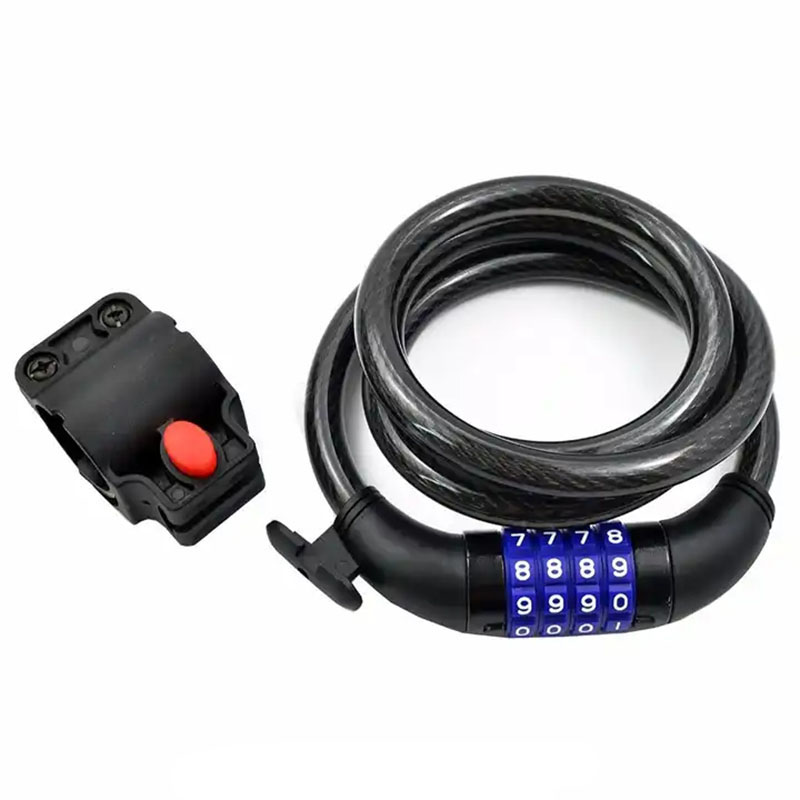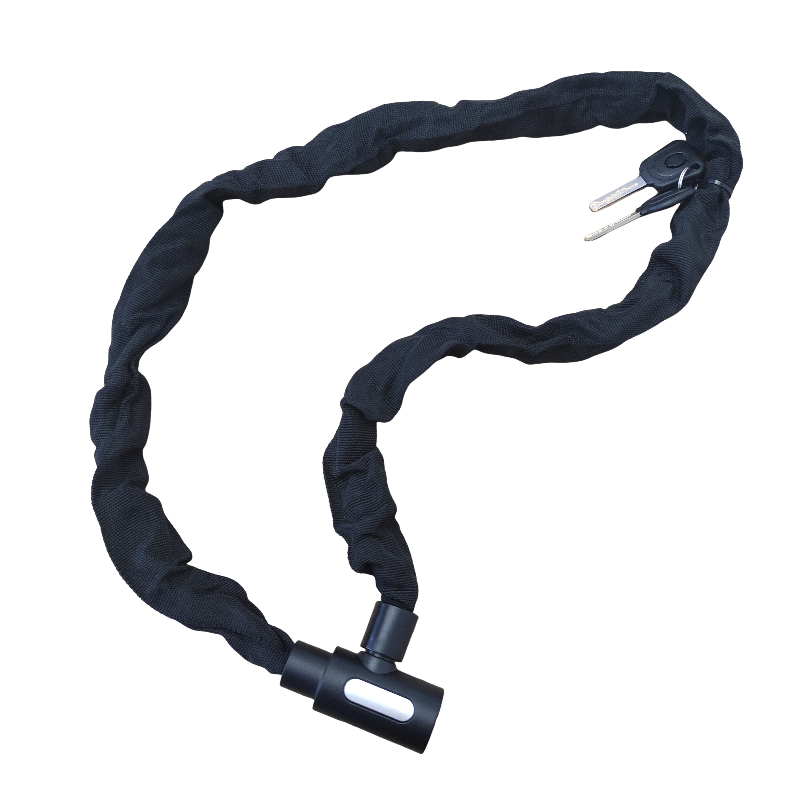اليوم سرقة الدراجة تلوح في الأفق كمشهقة كبيرة لراكبي الدراجات على مستوى العالم, وبالتالي فإن اختيار قفل الدراجة المضاد للسرقة أمر بالغ الأهمية. لتأمين دراجتك بفعالية, من الأهمية بمكان فهم الميزات والوظائف المحددة لأنواع القفل المختلفة. سوف تستكشف هذه المقالة 4 الأنواع الشائعة: أقفال, أقفال الكابل, أقفال سلسلة, وأقفال قابلة للطي. هل انت مستعد? دعنا نذهب.
أنواع شائعة من أقفال الدراجات
أ قفل الدراجة هو جهاز أمان لمنع السرقة عن طريق تأمين دراجة إلى كائن ثابت, مثل رف الدراجة أو القطب, عادة استخدام مجموعة أو آلية مفتاح. إنه ملحق أساسي عندما يؤمن الدراجة دراجة. لتعزيز مستوى الأمان, يأتي مع أنواع مختلفة. في هذا الجزء, سوف نتعلم الفروق بين أقفال U, أقفال قابلة للطي, أقفال سلسلة, وأقفال الكابل, وهي أمر بالغ الأهمية لراكبي الدراجات الذين يتطلعون إلى حماية دراجاتهم بفعالية.
ش القفل

u locks, المعروف أيضًا باسم الأقفال على شكل حرف U أو أقفال القيود, يتكون من شريط معدني صلب على شكل حرف U متصل بآلية قفل العارضة. الاسم “U-lock” يستخدم أكثر شيوعا في أمريكا, بينما يفضل بعض مصنعي قفل الدراجات في المملكة المتحدة تسميته قفلًا على شكل D أو على شكل D لأنه يتميز بتصميم على شكل حدوة حصان. يوفر تصميم هذه الأقفال مستوى عالٍ من الأمن بسبب بناء الصلب المتصلب ومقاومة أدوات القطع. تتميز بعض بقايا U الممتازة بأغلال صلبة مزدوجة القفل, إضافة طبقة إضافية من الحماية ضد محاولات السرقة.
أوصي بالحجم للتقدم
u locks يمكن تأمين الإطار والعجلة إلى جسم غير منقولة مثل رف الدراجة أو القطب, خاصة في المناطق الحضرية ذات السرقة العليا. بانتظام, قفل U متوسطة الحجم بقطر القيود يتراوح بين 12 و 15 ملم كبيرة بما يكفي; بينما إذا كنت ترغب في قفل سكوتر أو دراجة نارية, قد يكون أفضل 15-18 ملم و 18 ملم أو أكثر أفضل.
إيجابيات وسلبيات
| إيجابيات | سلبيات |
| ● تصميم مضغوط ومحمول للاستخدام المريح ● مستوى الأمن العالي بسبب البناء القوي ● مقاومة لأدوات القطع والاستفادة من الهجمات ● تطبيق متعدد الاستخدامات لتأمين أجزاء مختلفة من الدراجة | ● ثقيل نسبيًا مقارنة بأنواع القفل الأخرى ● مرونة محدودة عند تأمين الدراجات في مواقع غير تقليدية |
قفل الكابل

تتكون أقفال الكابل من قوية, الكابلات المرنة المصنوعة من الصلب المضفر أو المواد المعززة. هم غالبًا ما يأتي مع مفتاح متكامل أو تركيبة قفلق, تقديم الراحة أثناء الاستخدام. لكن, من الأفضل استخدامها كأقفال ثانوية بدلاً من التدابير الأمنية المستقلة.
أوصي بالحجم للتقدم
أقفال الكابلات غير القابلة للتطبيق مناسبة لتأمين الملحقات مثل الخوذات أو السروج في بيئات منخفضة المخاطر. عادة, قفل كابل متوسطة الطول يتراوح سماكة 10-12 مم يؤمن بشكل كاف الدراجات أو الدراجات البخارية لرفوف الدراجات أو المنشورات. لكن, قد لا يكون قفل الكابل وحده من الحكمة قفل الدراجة النارية, وبالتالي يجب أن تجمع بينه مع أقفال ثانوية أو أقفال دراجة شاقة.
إيجابيات وسلبيات
| إيجابيات | سلبيات |
| ● الرادع البصري ● خفيفة الوزن ومحمولة للغاية لراكبي الدراجات أثناء التنقل ● مرنة بما يكفي لتأمين مكونات الدراجات المتعددة في وقت واحد ● مثالي للتوقف على المدى القصير في المناطق منخفضة المخاطر | ● عرضة للقطع بسهولة عن طريق اللصوص باستخدام الأدوات الأساسية ● لا ينصح بمثابة تدابير أمنية مستقلة في المناطق ذات السرعة العالية ● قد يترك وضع القفل المهمل فجوات, تمكين الرافعة المالية أو قطع الهجمات بين الدراجة والكائن/الحامل ● استخدام قفل غير مستقر عند تعريض روابط السلسلة قد يضر بأعمال الطلاء بالدراجة دون الأكمام البلاستيكية الواقية أو البالية |
أقفال قابلة للطي

تتميز أقفال قابلة للطي للدورات بتصميم قابل للطي, مع شرائح متعددة تتكشف لإنشاء آلية قفل آمنة, ضمان التخزين المدمج وقابلية النقل. تضم مواد الصلب أو سبائك, فهي متينة ومقاومة لأدوات القطع. مصمم لتناسب أحجام إطار الدراجات المختلفة, إنهم يؤمنون الدراجة إلى جسم غير منقولة.
أوصي بالحجم للتقدم
بانتظام, قفل قابلة للطي متوسطة الحجم مع قضبان فولاذية متعددة وطول إجمالي يبلغ حوالي 80-100 سم مناسبة لتأمين الدراجات أو الدراجات البخارية للأشياء الثابتة. ولكن إذا كنت تريد قفل الدراجة النارية, لا يجوز لك سوى خدمته كخيار إضافي بسبب حد حجمه. سيكون من الأفضل دمجها مع أقفال أثقل في الخدمة.
إيجابيات وسلبيات
| إيجابيات | سلبيات |
| ● محمول وخفيف الوزن ● خيارات قفل متعددة الاستخدامات ● مقاومة لقطاعات الترباس ● مناسبة لأحجام إطار الدراجات المختلفة | ● طول محدود مقارنة بالأقفال التقليدية ● قد تتطلب رعاية إضافية لمنع التشويش ● تكلفة أعلى من أقفال الكابلات الأساسية ● قد تكون بعض النماذج عرضة للتآكل بمرور الوقت |
أقفال سلسلة

قفل سلسلة, شائع المصنوع من الصلب المتصل للسلسلة والنحاس أو الصلب, هو جهاز سلسلة أمان للدراجات, الدراجات النارية, وغيرها من العناصر القيمة. يتكون عادةً من سلسلة فولاذية ذات روابط متشابكة وأقفال شاقة مع الطلاء المقاوم للطقس. وتشمل الميزات المتانة, مقاومة القطع والعبث, والمرونة لتأمين كائنات مختلفة.
أوصي بالحجم للتقدم
عمومًا, قفل سلسلة أمان يتراوح طوله بين 90-120 مم وامتداد 8-12 ملم مناسبة لتأمين الدراجات لأشياء ثابتة مثل رفوف الدراجات أو الأعمدة. على غرار دراجة في الطول, قد تكون السلسلة الأكثر سمكا مع 10-14 ملم أفضل للدراجات البخارية. قفل سلسلة لا يقل عن 120 سم أو أطول وسمك 12-16 مم يستوعب حجم الدراجات النارية الأكبر.
إيجابيات وسلبيات
| إيجابيات | سلبيات |
| ● متينة ومقاومة للقطع أو العبث ● يقدم رادعًا مرئيًا لللصوص المحتملين ● يوفر المرونة في تأمين كائنات مختلفة في مواقع مختلفة | ● قد تكون مرهقة للحمل ● يتطلب نقطة مرساة مناسبة للاستخدام الفعال ● يمكن أن يسبب التعرض للطقس تدهورًا بمرور الوقت |
مقارنة مع أربعة أنواع من أقفال الدراجات
لديك فهم شامل للأقفال القابلة للطي, u locks, أقفال سلسلة, أو أقفال الكابل, لكن هل تعرف ما هو أفضل? دعونا نستكشف تكوين المواد والآلية القفل الخاصة بهم لتحديد قفل الدراجة الأكثر فعالية لاحتياجاتك.
قوة المواد
u locks أو d-locks للدورات, مثل TP-610866, يتباهى الصلب المصلب مع قوس متزايد لمقاومة أدوات القطع وهجمات القوة الغاشمة, القضاء على العديد من اللصوص المحتملين.
على الجانب الآخر, تتميز الأقفال القابلة للطي, ضمان حاجز قوي ضد محاولات السرقة.
أقفال سلسلة مثل TP-610606 عادة ما تكون مصنوعة من الصلب المتصلب, توفير قوة شد عالية ومقاومة لأدوات القطع مثل قواطع الترباس أو المناشير. بجانب, قد تتميز بعض أقفال سلسلة المركب بطبقات تعزيز أو سبائك إضافية لتعزيز المتانة والأمان.
لكن, بينما مريحة, غالبًا ما تسوية أقفال الكابلات المضادة للسرقة قوة المواد, جعلها أكثر عرضة لقطع الهجمات وتقليل فعاليتها في البيئات عالية الخطورة.
آلية قفل
تستخدم U-Locks أو D-locks آلية قفل واضحة ولكنها فعالة, مع قيود صلبة أو مفتاح قفل يحبس العارضة. يوفر هذا التصميم نقطة مرساة آمنة. على سبيل المثال, قفل الدراجة بأسعار معقولة TP-610853 يوفر 3 مفاتيح احتياطية لتجنب المفاتيح المفقودة, مثالي للطلاب أو الركاب في المناطق ذات المخاطر المنخفضة.
أقفال قابلة للطي, على الجانب الآخر, توظيف سلسلة من الأجزاء المترابطة التي تتكشف لإنشاء آلية قفل آمنة. على سبيل المثال, TP-610925 سمات 27 العقد المترابطة وقفل مجموعة رقمية, السماح لراكبي الدراجات بتأمين دراجاتهم في مواقف مختلفة.
عادة ما تستخدم أقفال السلسلة القفلات مع آليات المفتاح أو الجمع. تتميز بقفلاتهم بأغلال وألواح مكافحة الحفر لمقاومة الهجمات, وقد تتضمن النماذج المتقدمة محتجز أقراص أو أسطوانات لأمان إضافي ضد الانتقاء أو التلاعب.
في حين أنها مريحة بسبب مرونتها, توفر أقفال الكابلات آلية قفل أقل أمانًا. لكن, بعض أقفال كابلات السلك للدراجات النارية مع أقفال مزيج مثل TP-610926 تعويض عيب المفتاح (قد يختار القلم قفل المفتاح). إنها تسمح لك بإلغاء قفل الدراجة فقط 3 كلمات المرور الرقمية.
كيفية اختيار واحد مناسب لأمن الدراجة?
عند اختيار أفضل قفل دراجة لتلبية احتياجات الأمان الخاصة بك, يجب مراعاة عدة عوامل لضمان حماية شاملة ضد السرقة.
تقييم احتياجاتك الأمنية
يجب تخصيص اختيار نوع قفل الدراجة لمتطلبات الأمان المحددة التي تمليها الموقع. في المناطق الحضرية مع ارتفاع معدلات سرقة الدراجة, إن قفل قوي ومرن مثل القفل U أو D-Lock ضروري لحماية الدراجات القيمة بشكل فعال. على الجانب الآخر, في الإعدادات الريفية التي قد تكون فيها حوادث السرقة أقل تواتراً, قد يختار راكبي الدراجات خيارًا أكثر تنوعًا وخفيفة الوزن مثل قفل السلسلة, قفل الكابل, أو قفل قابل للطي دون المساس بالأمان.
التوازن بين Safty والراحة
غالبًا ما يواجه راكبي الدراجات سيناريوهات حيث يحتاجون إلى تأمين دراجاتهم عدة مرات طوال اليوم, مثل أثناء العمل أو يدير المهمات. لذلك, من المهم بنفس القدر تحقيق توازن مع الراحة عند اختيار قفل الدراجة. إذا قفلت الدراجة مرة أو مرتين في اليوم, سيكون قفل سلسلة مزيج مع D-lock أو U-Lock على ما يرام. ولكن إذا قفلت الدراجة 3 مرات, فرد D-lock, U-lock, أو قفل طي سيكون أفضل.
تقدير قيمة الدراجة
تتضمن الدراجات ذات القيمة العالية أقفال أقوى وأكثر ثباتًا توفر حماية معززة ضد محاولات السرقة. على العكس, قد تكون الدراجات ذات القيمة المنخفضة كافية مع أقفال آمنة معتدلة توفر ردعًا كافيًا ضد اللصوص الانتهازية.
خاتمة
طوال هذا الاستكشاف لأقفال الدراجات, يصبح من الواضح أن كل نوع قفل يمتلك ميزات وتطبيقات فريدة مصممة لمعالجة مخاوف أمان محددة.
✓ D-Locks أو أقفال الدراجات U-Bolt تبرز لبناءها القوي ومقاومة أدوات القطع, جعلها مثالية للإعدادات الحضرية عالية الخطورة.
✓ ثم توفر الأقفال القابلة للطي فوائد براعة وأمان, تقديم الطعام لراكبي الدراجات الذين يبحثون عن حلول قفل مدمجة ولكنها قوية.
✓ إلى جانب ذلك, توفر أقفال السلسلة المتانة مع بناء الصلب المتصلب, مثالي لاحتياجات الأمن الحضري. يقاوم أدوات القطع مع توفير حماية كائنات متعددة الاستخدامات.
✓ في هذه الأثناء, توفر أقفال الكابلات خيارات خفيفة الوزن ومرنة لتأمين الملحقات في المناطق منخفضة الخطورة ولكن لا ينصح بها كتدابير أمان مستقلة.
لذلك, يجب أن تصدر أقفال الدراجة من البعض ماركات قفل الدراجة الجيدة أو بيعها بناءً على الاحتياجات الفردية, تمكين راكبي الدراجات من التخفيف.
التعليمات
1. أي قفل غير قابل للكسر?
لا يوجد قفل غير قابل للكسر حقًا, نظرًا لأن أي قفل يمكن اختراقه نظرًا لوقت ما يكفي, أدوات, والتصميم. لكن, أقفال معينة, مثل الأوقاف ذات الأمن العالي مع أجسام فولاذية صلبة وأنظمة رئيسية معقدة, تقدم مقاومة كبيرة للاختيار, قطع, وطرق العبث الأخرى.
2. ما هو مستوى أمان أقفال الدراجات?
يتم تصنيف أقفال الدراجة على مقياس من البرونز, فضي, ذهب, والماس, مع ارتفاع التصنيفات التي تشير إلى مستويات أمنية أعلى. تستند المستويات إلى المدة التي سيستغرقها اللص لكسر القفل:
1. البرونز: أمن منخفض/متوسط, مصممة لمنع الجريمة الانتهازية
2. فضي: الأمن المتوسط/العالي, مصمم لمنع هجوم أكثر تحديدًا
3. ذهب: الحد الأقصى للأمن, مصمم لمنع الهجمات المخصصة
4. الماس: الأمن النهائي, مصممة لمنع الهجمات الأكثر تدميرا

















